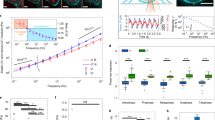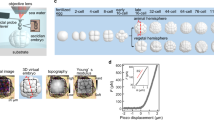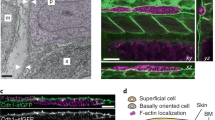Abstract
Animal cells dividing in culture undergo a dramatic sequence of morphological changes, characterized by cytoskeletal disassembly as cells round up, redistribution of actin, myosins and other cytoplasmic and surface molecules into the cleavage furrow1–11, and respreading12, before daughter cells finally separate at the mid-body13. Knowledge of forces governing these movements is critical to understanding their mechanisms, including whether formation of the cleavage furrow results from increased force generation at the equator14,15 or relaxation at the poles16, and whether traction force subsequently mediates cytofission of the intercellular bridge5,13,17,18. We have quantitatively mapped traction forces in dividing cells, by extending the silicone-rubber substratum method19 to detect forces of nanonewtons to micronewtons. We used a new silicone polymer to fabricate substrata whose compliance can be adjusted precisely by ultraviolet irradiation. We show that traction force appears locally at the furrow in the absence of relaxation at the poles during cleavage. Force also rises as connected daughter cells respread and attempt to separate, suggesting that tension contributes to the severing of the intercellular bridge when cytokinesis is completed.
This is a preview of subscription content, access via your institution
Access options
Subscribe to this journal
Receive 51 print issues and online access
$199.00 per year
only $3.90 per issue
Buy this article
- Purchase on Springer Link
- Instant access to full article PDF
Prices may be subject to local taxes which are calculated during checkout
Similar content being viewed by others
References
Fishkind, D. J. & Wang, Y. L. Curr. Opin. Cell Biol. 7, 23–31 (1995).
Salmon, E. D. Curr. Opin. Cell Biol. 1, 541–547 (1989).
Cao, L. G. & Wang, Y. L. J. Cell Biol. 111, 1905–1911 (1990).
Sanger, J. M., Dome, J. S., Hock, R. S., Mittal, B. & Sanger, J. W. Cell Motil. Cytoskeleton 27, 26–40 (1994).
Fukui, Y. Int. Rev. Cytol. 144, 85–127 (1993).
Mabuchi, I. J. Cell Sci. 107, 1853–1862 (1994).
Maupin, P., Phillips, C. L., Adelstein, R. S. & Pollard, T. D. J. Cell Sci. 107, 3077–3090 (1994).
DeBiasio, R. L., LaRocca, G. M., Post, P. L. & Taylor, D. L. Mol. Biol. Cell 7, 1259–1282 (1996).
Breckler, J. & Burnside, E. Cell Motil. Cytoskeleton 29, 312–320 (1994).
Field, C. M. & Alberts, B. M. J. Cell Biol. 131, 165–178 (1995).
Wang, Y. L., Silverman, J. D. & Cao, L. G. J. Cell Biol. 127, 963–971 (1994).
Cramer, L. P. & Mitchison, T. J. J. Cell Biol. 131, 179–189 (1995).
Mullins, J. M. & Biesele, J. J. J. Cell Biol 73, 672–684 (1977).
Rappaport, R. Int. Rev. Cytol. 105, 245–281 (1986).
Harris, A. K. in Biomechanics of Active Movement and Division of Cells (ed. Akkas, N.) NATO ASI Series Vol. H84, 37–66 (Springer, Berlin, 1994).
White, J. G. & Borisy, G. G. J. Theor. Biol 101, 289–316 (1983).
Rappaport, R. & Rappaport, B. N. J. Exp. Zool 240, 55–63 (1986).
De Lozanne, A. & Spudich, J. A. Science 236, 1086–1091 (1987).
Harris, A. K., Wild, P. & Stopak, D. Science 208, 177–179 (1980).
Rappaport, R. Nature 156, 1241–1243 (1967).
Hiramoto, Y. in Cell Motility: Molecules and Organization (eds Hatano, S., Ishikawa, H. & Sato, H.) 653–663 (Univ. Tokyo Press, 1979).
Fishkind, D. J. & Wang, Y. L. J. Cell Biol. 123, 837–848 (1993).
Fukui, Y. & Inoué, S. Cell Motil. Cytoskeleton 18, 41–54 (1991).
Bray, D. & White, J. G. Science 239, 883–888 (1988).
Shu, H. B., Li, Z., Palacios, M. J., Li, Q. & Joshi, H. J. Cell Sci. 108, 2955–2962 (1995).
Harris, A. K. Methods Enzymol. 163, 623–642 (1988).
Harris, A. K. J. Biomech. Eng. 106, 19–24 (1984).
Oliver, T., Dembo, M. & Jacobson, K. Cell Motil. Cytoskeleton 331, 225–240 (1995).
Burton, K. & Taylor, D. L. Mol. Biol. Cell 4, 114a (1993).
Peterson, M. A. Biophys. J. 71, 657–669 (1996).
Dembo, M., Oliver, T., Ishihara, A. & Jacobson, K. Biophys. J. 70, 2008–2022 (1996).
Author information
Authors and Affiliations
Rights and permissions
About this article
Cite this article
Burton, K., Taylor, D. Traction forces of cytokinesis measured with optically modified elastic substrata. Nature 385, 450–454 (1997). https://doi.org/10.1038/385450a0
Received:
Accepted:
Issue Date:
DOI: https://doi.org/10.1038/385450a0
This article is cited by
-
Vesicle-mediated transport of ALIX and ESCRT-III to the intercellular bridge during cytokinesis
Cellular and Molecular Life Sciences (2023)
-
Wrinkle force microscopy: a machine learning based approach to predict cell mechanics from images
Communications Biology (2022)
-
Establishment of a system evaluating the contractile force of electrically stimulated myotubes from wrinkles formed on elastic substrate
Scientific Reports (2022)
-
Cep55 promotes cytokinesis of neural progenitors but is dispensable for most mammalian cell divisions
Nature Communications (2020)
-
Measuring mechanical stress in living tissues
Nature Reviews Physics (2020)
Comments
By submitting a comment you agree to abide by our Terms and Community Guidelines. If you find something abusive or that does not comply with our terms or guidelines please flag it as inappropriate.



